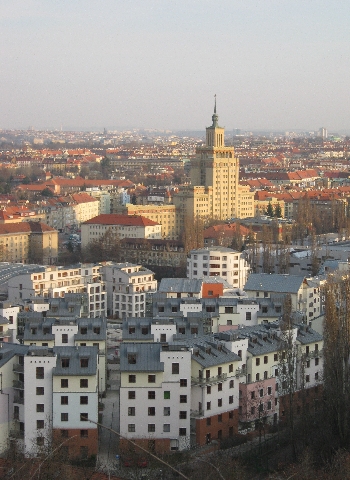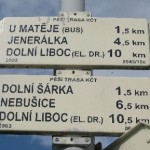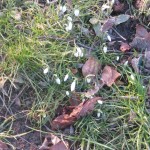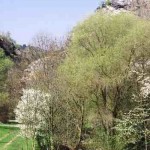
The immediate area of Prague in which our home, the Chaplaincy Flat, is situated is known as Podbaba. The terminal station for the Number 8 Tram which we catch to travel into the City Centre to reach St. Clement’s Church, is also called ‘Podbaba’. ‘Pod’ in Czech means ‘under’ and behind our flats complex lies a steep wooded ridge between the Vltava and Šárka valleys which is called ‘Baba’. Hence we live in Podbaba – ‘under Baba’.
We regularly walk up the tarmac pathway through the woods, which leads from our flats complex up onto the Baba ridge. From the ridge, there are some wonderful views which I hope these three accompanying photographs help to illustrate.
In the foreground of the first photograph is our flats complex that the developers like to call ‘Residence Podbaba’. You can follow the link to the English version of the sales website. Our flat was built as part of the first phase of the development and my predecessor as Chaplain, John Philpott and his wife Margaret, moved into it just over four years ago in January 2006. It is located in the building immediately below the orangey-red square patch in the middle of the photograph.
The orangey-red square patch is on a building directly opposite our main balcony and is part of the fourth and final phase of the whole development. This has been under construction for the whole of the nearly 19 months we have lived here. Fortunately, the building work is now almost complete with the laying of paths and landscaping being undertaken in the last few weeks.
The tall building behind the ‘Residence Podbaba’ flats development is a wonderful example of the architectural style usually known as ‘Stalinist Baroque’. It is based on the design of Moscow University and was originally built during the communist era, as a hotel for visiting senior military personnel from Warsaw Pact countries. These days it functions in a more capitalist manner as the Austrian owned ‘Crowne Plaza Hotel’. However, Sybille always refers to the star on the pinnacle of the tower as the ‘Star of Stalingrad’!

The end of the Baba ridge directly overlooks the Vltava River which runs through the centre of Prague. As I have written previously, the River Vltava is navigable from where it leaves the Labe/Elbe at Melnik, all the way to Prague and onwards to the Slapy Dam. This picture shows Podbaba Lock with Hydrolologický Ústav (the Hydrological Station) in front of it and Prague’s main sewage works behind. Amazingly, we have never experienced any foul smells despite the sewage works being in such close proximity.

This next photograph shows the view looking towards the centre of Prague. In the foreground is ‘Residence Podbaba’ with part of the orangey-red patch just visible on the right. In the middle-distance left is the distinctive tower of the Crowne Plaza Hotel. In the far distance on the left is St. Vitus Cathedral which lies within the walls of Prague Castle. On the right in the far distance, is Petrin Hill, with a smaller version of the Eiffel Tower on top.
Not only does the Baba ridge provide wonderful views across Prague, it is also the location of a fascinating model housing exhibition dating from the early 1930s. The construction of the Baba Ideal Housing Estate, as with similar ones in Vienna and Budapest, was inspired by the success of the Weissenhofsiedlung, a housing exhibition that had been mounted by the Deutsche Werkbund (German Work Federation) in Stuttgart in 1927. The Werkbund was a group of enterprising architects and designers founded in Munich in 1907 by Hermann Muthesius. Somewhat similar to the Viennese Wiener Werkstätte and the English Arts and Crafts Movement in their production of quality products, they differed in being unopposed to reaping the financial rewards made possible through industrial mass production.
In September 1932 the Czech Werksbund mounted their own model housing exhibition under the guidance of the Modernist architect and town planner Pavel Janák. They selected the Baba ridge as the location for their exhibition and thirty three houses, by a variety of architects, were erected. Set side-by-side so their qualities could be judged comparatively, they are strung out along the sloping terrain so as to maximise the view from each building. The houses were individually and specifically designed to provide simple, and affordable yet innovative living spaces for ordinary families.




Meant to be only temporary, the geometric Bauhaus-style houses, which still appear modern today, were ultimately bought up by the Czech avant-garde, having proved too expensive for the original target market. In more recent times, many have been divided into two or three flats.





Whilst most of these architectural gems are in good order, a small number are in need of rescue and renovation. This one is an example of one that could do with a little bit of tender, loving care.




Ricky,
I really enjoyed your blog! Great pictures! Somehow, I had it in my mind you lived FAR out, but in fact you are fairly close in! Do you use the hotel tower as your landmark? Our landmark, when we stayed over the winter was the Zizkov Radio Tower as we were in Vinohrady. No matter how far we went on the Metro….we would come out and there in the distance was the Radio Tower! Prague is pretty compact.
Love the Bauhaus style house pictures. Thank you for the “sightseeing trip around your area”.
Karin on Paros
.-= Karin Shepherd´s last blog ..April Tango on Paros =-.
Hi Karin,
I’m glad you enjoyed this last blog post. No – we don’t live that far out. On a Sunday, it is 18 minutes on the tram from the Podbaba tram terminus (directly in front of the Crowne Plaza Hotel) to Dloha trida, the tram stop nearest to St. Clement’s Church.
Yes – we do use the hotel tower as a landmark. Whilst it is not as prominent as the Zizkov Radio Tower, it still is quiet observable from various viwpoints within Prague.
The Baba Estate with the Bauhaus-style houses is a facinating place to walk around. One of these days I would like to see the inside of one of the houses. Unfortunately, I’ve yet to meet any of the current owners!
Great and very thorough article! I am very familiar with the Bauhaus / Werkbund style of architecture as it comes from my country of origin 😉 But looking at these images I seriously doubt that this mansions were ever inhabited by “people like you and me”. And, do I notice the lovely face of Prince K.Schwarzenberg on one of the balconies? Does he live there or is that just a banner one of his supporters hang out? SY
.-= hospitalera@metal carports for sale´s last blog ..What to Consider with Metal Carports for Sale =-.